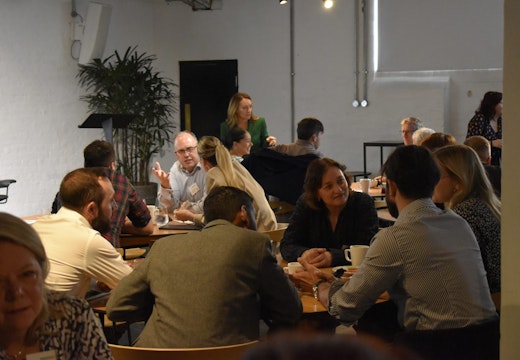Why it’s time for leaders to future-proof the financial workplace
Financial service firms are being pulled in multiple directions as they try to establish a new working model. But as WORKTECH conferences in New York and London suggest, there is ample opportunity to innovate
The financial workplace in New York and London stands at a crossroads as the competition for talent, the regulatory framework, the environmental agenda and the disruptive effects of both hybrid working and new technology pull financial organisations in a host of sometimes contradictory directions.
That’s the message from our analysis of more than 50 speakers and presentations at two specialist finance focused WORKTECH conferences held earlier this year at Wells Fargo’s New York headquarters on 27 February and at M&G’s London headquarters on 15 March 2024.
Our panels of experts in New York and London were agreed that aligning people, place and technology to create a financial workplace fit for the future is not easy to achieve – and getting harder. However, both events revealed a drive for innovation in the sector and some clear directions for company leaders to act on:
Innovation in the sector
Data-led decision making: The rise of hybrid working has created unprecedented challenge for financial firms built around traditional working patterns and behaviours. As the hybrid model settles into permanence, companies find themselves on a digital transformation journey in terms of workplace management that will increasingly rely on data to make real-time decisions. At the New York conference, Vista Equity Partners introduced a ‘workplace maturity model’ with four levels, providing a ladder of opportunity for companies willing to focus technology on building a more connected and coordinated workplace.
Digital storytelling: Against the background of a slow return to the office in many large financial institutions, there is now a strong imperative to create more of a sense of connection and belonging for employees and visitors. The emerging discipline of digital storytelling, which can communicate and share relevant stories about the organisation and its people in an ambient and artistic way via large-screen and immersive displays, is a growing theme in the financial workplace, as Wells Fargo explained. The Bank of America Tower in Charlotte, USA and the Salesforce Tower in Sydney were cited as inspiring examples of digital storytelling.
Workplace apps: Workplace apps were also high on the agenda at the London and New York conferences. As organisations seek to boost workplace experience for employees and visitors alike, workplace apps are the place to start. In New York, we heard about M&G’S use of Spica’s GemEx Engine app (also featured in the WORKTECH Guide to Workplace Apps), which covers areas from workplace experience and space management to smart cleaning. Modo’s workplace solution was also discussed, a user-friendly app that facilitates connection between teams, promotes organisational efficiency and supports a greener workplace. The workplace apps sector is constantly expanding, and there seems to be a clear trend towards super apps that work as a one-size-fits-all solution, supporting the entire workplace ecosystem.
Connections to nature: Many financial service firms have traditionally located in dense business hubs or districts that lack any connection to the natural world and can adversely affect employee wellbeing. Large employers in the financial sector can avoid a mechanistic workplace through a variety of ways, as leading architect Eric Parry told the London conference. Whether through digital screens that connect you to images of the sky, or through the introduction of biophilic scenescapes and workplace gardens, connections to nature can be essential to improved wellbeing. Parry’s studio is working on major schemes in London where projects include 1 Undershaft, which will be London’s tallest tower, and 10 Fenchurch Avenue, which has a large, publicly accessible rooftop garden.
Workplace pilots: Both the London and New York events emphasised the importance of conducting workplace pilots to test new ideas and evaluate results. Experts explained that innovative approaches to creating and measuring more adaptable workspaces needed to be piloted first. Case studies from Wells Fargo, BNY Mellon and Mastercard, which introduced a new digitised onboarding process to better support its global hiring, provided evidence for this approach. Generally, the riskier the pilot, the more it should be tested at the periphery of the organisation rather than at the centre. Risk-averse financial firms struggle with the ‘fail fast to succeed sooner’ mantra but there are valuable lessons from pilots that fail. Attitudes in the industry need to change.
Human-centred design: As people return to the office, whether mandated to do so or not, they often miss the levels of personal comfort and customisation they experienced during the lockdowns in the pandemic. How can the financial workplace of the future address this fundamental human factor? Experts discussed the importance of human-centred design to make office buildings warmer, softer and more familiar places to be. Creating a home from home emerged as a priority, with a focus on materials, lighting, art, sustainable design and space-planning aligned with more flexible policies around team building and neighbourhoods. A case study of M&G retrofitting of its office in 10 Fenchurch Avenue illustrated many of these points.
Technologies to reduce risk: The more digitisation that is put in place in the financial workplace, the more avenues there are for risk – so the focus now needs to be on mitigating these risks. Preventing ransomware cyber-attacks is the highest priority. There are also challenges in incorporating cryptocurrencies, biometrics, blockchain and cognitive computing, accommodating the need for real-time data integration across multiple devices, implementing gamification simulations, and introducing robo-advisors based on mathematical algorithms, according to the London and New York events.
Financial workplace in numbers
- Financial service companies committed to reducing their carbon footprint 45-50 per cent by 2025 include: Bank of America, Barclays, BNP Paribas, Citi, Deutsche Bank, Goldman Sachs, HSBC, ING, JP Morgan, Santander, Standard Chartered, Wells Fargo, and more.
- The Workplace Index by Eptura revealed a 47 per cent growth in NYC desk bookings compared to a 40 per cent growth across the rest of the USA; there was also a 41 per cent increase in room bookings in NYC compared to just 10 per cent across the rest of the USA
- The future is multi-platform: according to Cisco’s Collaboration Devices Decision-Maker Survey, over 85 per cent of organisations support two or more meeting platforms.
- UK employers are the most efficient users of desks – needing just 59 desks per 100 employees, according to data shared by Gregory Shewan of architects HOK.
- 27 per cent of jobs in the world’s wealthiest countries are at risk of being replaced by AI, according to the OECD (Organisation for Economic Cooperation and Development) – with the caveat that AI won’t necessarily directly replace entire jobs, but rather will replace the people who don’t utilise AI.
- 68 per cent of companies lack a structured ‘playbook’ to guide their hybrid work model, according to data from McKinsey.
Conclusion
As the financial industry is now at an inflection point where it is being pulled in multiple directions, it will be the leaders who are proactive in implementing new workplace strategies and technologies that will be rewarded. This was true during the global pandemic and will be even more the case now.
Alongside well-defined workplace challenges, new entrants to the sector are spotting new challenges, particularly around collaboration which will be critical for their businesses to succeed. The impact of AI, augmented reality and spatial computing are still to be fully understood within financial services. So, it will be important to use data, apps, digital storytelling and human-centred design to support the user experience in the workplace, to connect with nature at the urban scale, to conduct and learn from pilots, and to invest in technologies to mitigate risk.
Future-proofing the financial workplace is no longer a general aspiration but has become an urgent corporate mission.
Financial workplace participants
London:
Morgan Stanley
American Express
Bank of China
Barclays
Blackstone
HSBC
Lloyds
London Stock Exchange
Standard Chartered Bank
Goldman Sachs
M&G Investments
New York:
American Express
Bank Of America
Black Rock
Citibank
Citizens Bank
Deutsche Bank
Goldman Sachs
Northern Trust
Blackstone Europe
Mastercard
Wells Fargo Bank
HSBC
Morgan Stanley
TD Bank
Vista Equity Partners
Further reading
Is hybrid really working? Jll, 2023
Is your workplace ready for flexible work? McKinsey & Company, 2023
Organisation for Economic Cooperation and Development (OECD), 2023
State of the Global Workplace: 2023 report, Gallup
The right to disconnect around the world, Ius Laboris, 2024
The Workplace Index, Eptura, Q4 2023








